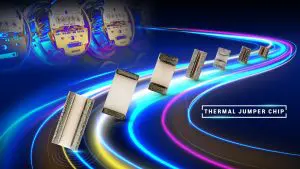TT Electronics has introduced its TJC series of thermal jumper chips, enabling circuit designers to manage temperature increases in compact power electronic assemblies. These parts provide a thermally conductive pathway with electrical isolation for management of PCB hotspot areas. Aluminum nitride, which has nearly five times the thermal conductivity of alumina, is employed … [Read more...]
Air Ionization Techniques for the Cooling of Electronic Devices: Analysis of the Different Effects of Design Features on Cooling Performance
Rotary fans have been used to cool electronic devices using forced convection applications to achieve the required heat transfer dissipation. In recent years, there has been an increasing trend to miniaturize the size and maximize the efficiency of the electronic devices which, in turn, increases heat generation. The use of rotary fan cooling conflicts with these new trends due … [Read more...]
You’re Sending That Heat “Away” to Where, Exactly?
Engineers are generally hard-nosed realists and don’t rely on the mythical kingdoms of fairy tales where only good things can happen and all problems disappear. Still, there is one magical place which is often called out when dealing with the thermal aspects of design, and it has the simple name of “away.” How so? Cooling devices and techniques – including heat sinks, heat … [Read more...]
The Impact of Hybrid Cooling on the Power and Computational Efficiency of Cloud Computing Racks
A noteworthy trend in data centers is to reduce the power consumption of cooling facilities by increasing the supplied temperature to IT services, thereby requiring less work within the cooling facility to provide the targeted temperature. This will result in lower overall power consumption and higher computational effectiveness. However, higher inlet water temperature to the … [Read more...]
Balancing Local Versus Global Cooling Requirements
When you’re planning how to solve the ongoing problem of keeping things cool enough, it’s easy to mentally blur the lines between hot components and hot boxes. The difficulty is that the solution for one of these may not be adequate or appropriate for the other. Here’s the situation: in most systems, the heat sources are not distributed uniformly across the circuit board … [Read more...]
- « Previous Page
- 1
- …
- 15
- 16
- 17
- 18
- 19
- …
- 56
- Next Page »








